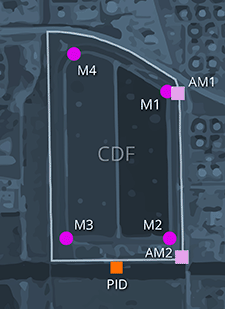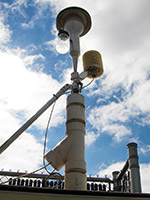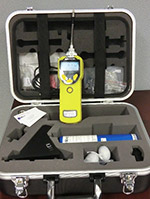Real-Time Air Monitoring
Real-time (short-term) air monitoring occurs during dredging and CDF operations to ensure activities are conducted safely to avoid negative impacts consistent with USEPA guidance.

Real-time air monitoring data is collected at four monitoring stations around the perimeter of the CDF cells and at the off-loading barge. This data is used for the management of the daily operation of the CDF. Air monitoring along the perimeter of the CDF measures emissions of particulate matter (PM). Each perimeter air monitoring station consists of a hybrid ambient particulate monitor for measuring PM10 and PM2.5. Historically, air monitoring at the dock area was also performed daily during dredging using a photo-ionization detector (PID).
Purpose of Real-Time Air Monitoring
The primary goals of real-time air monitoring are to:
- Monitor and verify the air quality at the site during dredging and CDF operations
- Manage site operations to avoid negative impacts of potential air emissions
- Ensure that work is conducted safely and effectively
- Ensure that CDF operations are consistent with USEPA guidance for air quality impacts and IDEM regulations for air quality
Types of Monitoring
Particulate Matter (PM)

Each perimeter air monitoring station includes a hybrid ambient particulate monitor for measuring PM10 and PM2.5 (dust). Data is collected every 15-minutes during operations.
Dock Area Photoionization Detector (PID) VOC Monitoring (Historical)

Air monitoring at the dock area was performed daily during dredging using a photo-ionization detector (PID). This monitoring provided data on the effects of sediment activity at the barge on emission levels for worker and community safety. From 2012 through 2020, dock face PID monitoring measurements never exceeded site action levels for VOCs for implementation of emission control measures. Dock face PID monitoring will be discontinued during future dredging.
PID Monitoring DataNaphthalene (Historical)

From 2012 to 2021, each perimeter air monitoring station included a two-part open-path ultraviolet differential optical absorption spectrometer (UV-DOAS) that measured naphthalene. These monitors collected data along an open path between two points. Naphthalene monitoring was discontinued in 2021. Historical data is available.
Meterological Station
A meteorological station at the CDF site was installed by the U.S. Geological Survey (USGS) in 2012, and is used to differentiate between upwind (background) and downwind (background plus CDF component) data. Background levels were determined by historical air quality statistics and are updated periodically based on upwind data. Action levels are based solely on the CDF component of the air quality results.

